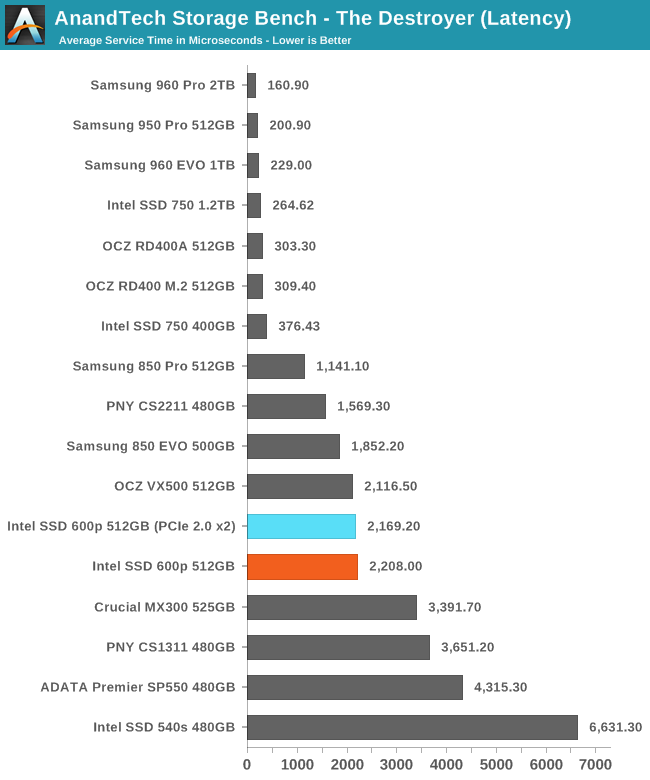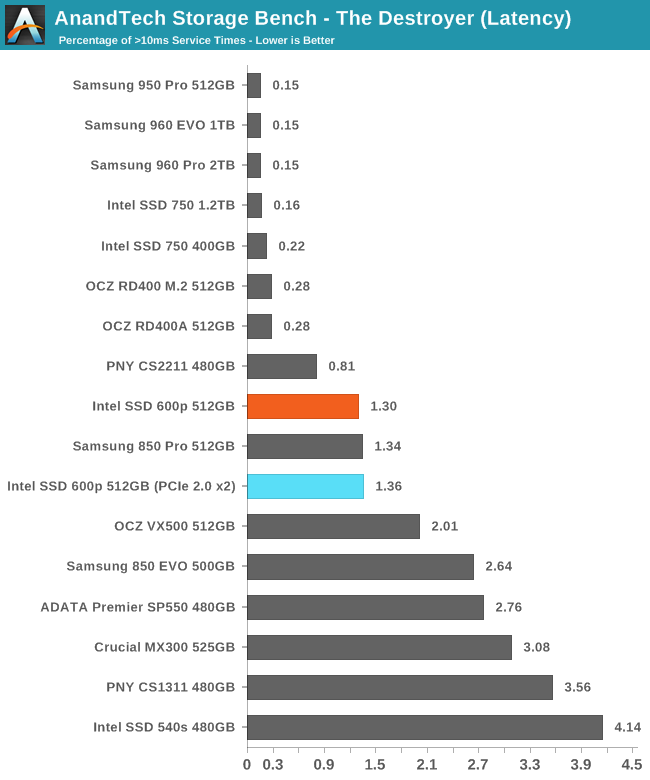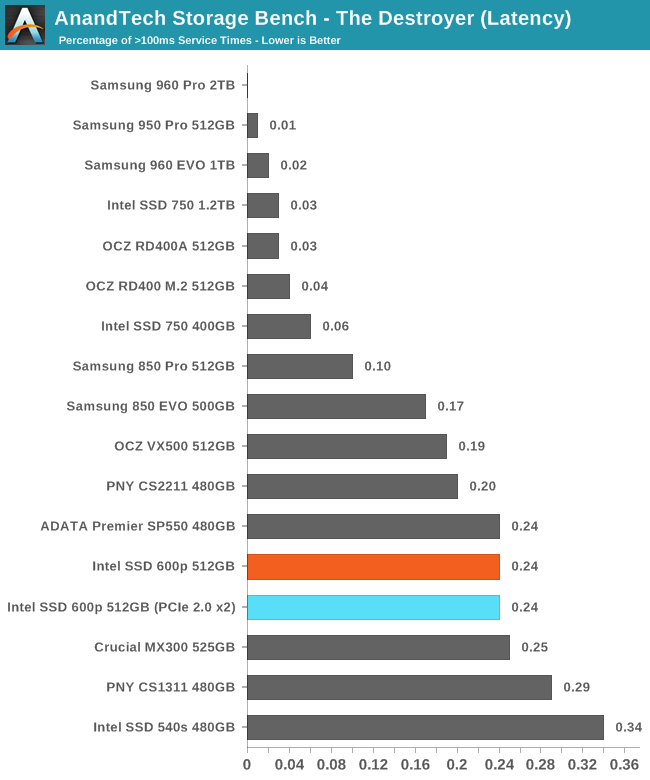The Intel SSD 600p (512GB) Review
by Billy Tallis on November 22, 2016 10:30 AM ESTAnandTech Storage Bench - The Destroyer
The Destroyer is an extremely long test replicating the access patterns of very IO-intensive desktop usage. A detailed breakdown can be found in this article. Like real-world usage and unlike our Iometer tests, the drives do get the occasional break that allows for some background garbage collection and flushing caches, but those idle times are limited to 25ms so that it doesn't take all week to run the test.
We quantify performance on this test by reporting the drive's average data throughput, a few data points about its latency, and the total energy used by the drive over the course of the test.

The average data rate sustained by the 600p on The Destroyer shows that the drive is almost entirely limited by the speed of the 3D TLC NAND, and it is barely any faster than the Crucial MX300 that uses the same NAND.

The average service time of the 600p is much lower than most TLC SSDs, so the NVMe PCIe interface is providing some latency benefit even when the drive's throughput doesn't need anything faster than SATA. The 600p is still only as good as a mid-range MLC SATA SSD and doesn't come close to the low latency of high-end NVMe drives.


The number of high latency outliers above the 10ms threshold and above 100ms tells two quite different stories. The 600p is as good as most MLC SATA drives at completing most of its operations in under 10ms, but when the drive stalls, it does so as severely as a budget TLC SATA SSD.

Operating a PCIe 3.0 x4 link requires quite a bit more power than a SATA link, so most PCIe SSDs start at a disadvantage in power consumption and make up for it by completing the test fast enough that the total energy used is not higher than is typical for SATA SSD. The 600p doesn't complete The Destroyer any quicker than a SATA SSD and the 40nm fab process used by the SM2260 controller doesn't do it any favors here either.










63 Comments
View All Comments
vFunct - Tuesday, November 22, 2016 - link
These would be great for server applications, if I could find PCIe add-in cards that have 4x M.2 slots.I'd love to be able to stick 10 or 100 or so of these in a server, as an image/media store.
ddriver - Tuesday, November 22, 2016 - link
You should call intel to let them know they are marketing it in the wrong segment LOLddriver - Tuesday, November 22, 2016 - link
To clarify, this product is evidently the runt of the nvme litter. For regular users, it is barely faster than sata devices. And once it runs out of cache, it actually gets slower than a sata device. Based on its performance and price, I won't be surprised if its reliability is just as subpar. Putting such a device in a server is like putting a drunken hobo in a Lamborghini.BrokenCrayons - Tuesday, November 22, 2016 - link
Assuming a media storage server scenario, you'd be looking at write once and read many where the cache issues aren't going to pose a significant problem to performance. Using an array of them would also mitigate much of that write performance using some form of RAID. Of course that applies to SATA devices as well, but there's a density advantange realized in NVMe.vFunct - Tuesday, November 22, 2016 - link
bingo.Now, how can I pack a bunch of these in a chassis?
BrokenCrayons - Tuesday, November 22, 2016 - link
I'd think the best answer to that would be a custom motherboard with the appropriate slots on it to achieve high storage densities in a slim (maybe something like a 1/2 1U rackmount) chassis. As for PCIe slot expansion cards, there's a few out there that would let you install 4x M.2 SSDs on a PCIe slot, but they'd add to the cost of building such a storage array. In the end, I think we're probably a year or three away from using NVMe SSDs in large storage arrays outside of highly customized and expensive solutions for compaines that have the clout to leverage something that exotic.ddriver - Tuesday, November 22, 2016 - link
So are you going to make that custom motherboard for him, or will he be making it for himself? While you are at it, you may also want to make a cpu with 400 pcie lanes so that you can connect those 100 lousy budget p600s.Because I bet the industry isn't itching to make products for clueless and moneyless dummies. There is already a product that's unbeatable for media storage - an 8tb ultrastar he8. As ssd for media storage - that makes no sense, and a 100 of those only makes a 100 times less sense :D
BrokenCrayons - Tuesday, November 22, 2016 - link
"So are you going to make that..."Sure, okay.
Samus - Tuesday, November 22, 2016 - link
ddriver, you are ignoring his specific application when judging his solution to be wrong. For imaging, sequential throughput is all that matters. I used to work part time in PC refurbishing for education and we built a bench to image 64 PC's at a time over 1Gbe with a dual 10Gbe fiber backbone to a server using, which was at the time the best option on the market, an OCZ RevoDrive PCIe SSD. Even this drive was crippled by a single 10Gbe connection let alone dual 10Gbe connections, which is why we eventually installed TWO of them in RAID 1.This hackjob configuration allowed imaging 60+ PC's simultaneously over GBe in about 7 minutes when booting via PXE, running a diskpart script and imagex to uncompress a sysprep'd image.
The RevoDrive's were not reliable. One would fail like clockwork almost annually, and eventually in 2015 after I had left I heard they fell back to a pair of Plextor M2 2280's in a PCIe x4 adapter for better reliability. It was, and still is, however, very expensive to do this compared to what the 600p is offering.
Any high-throughput sequential reading application would greatly benefit from the performance and price the 600p is offering, not to mention Intel has class leading reliability in the SSD sector of 0.3%/year failure rate according to their own internal 2014 data...there is no reason to think of all companies Intel won't keep reliability as a high priority. After all, they are still the only company to mastermind the Sandforce 2200, a controller that had incredibly high failure rates across every other vendor and effectively lead to OCZ's bankruptcy.
ddriver - Tuesday, November 22, 2016 - link
So how does all this connect to, and I quote, "stick 10 or 100 or so of these in a server, as an image/media store"?Also, he doesn't really have "his specific application", he just spat a bunch of nonsense he believed would be cool :D
Lastly, next time try multicasting, this way you can simultaneously send data to 64 hosts at 1 gbps without the need for dual 10gbit or an uber expensive switch, achieving full parallelism and an effective 64 gbps. In that case a regular sata ssd or even an hdd would have sufficed as even mechanical drives have no problem saturating the 1 gbps lines you to the targets. You could have done the same work, or even better, at like 1/10 of the cost. You could even do 1000 system at a time, or as many as you want, just daisy chain more switches, terabit, petabit effective cumulative bandwidth is just as easily achievable.